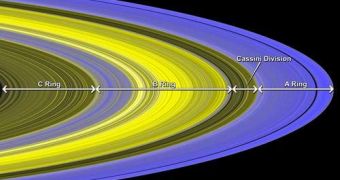Saturn is the second largest planet in the solar system, after Jupiter, and also a gas giant. Named after the Roman god Saturnus, it has a prominent system of rings, easy to spot with even a low-end observation equipment.
At first glance, Saturn's rings may appear solid when viewed from Earth, due to the density that produces a continuous image. A new set of images provided by NASA's Cassini spacecraft shows that, in fact, the rings are made of tightly packed clumps of particles in constant collision with one another.
It seems the astronomers were wrong at approximating the mass of the rings, which were thought to be consisting mostly of lightweight ice particles with a smaller amount of rocky debris and dust. The new observations point to them being two or more times more massive than previously thought.
"The rings are different from the picture we had in our minds," said study leader Larry Esposito of the University of Colorado, Boulder. "If you were flying under Saturn's rings in an airplane, you would see these flashes of sunlight come through the gaps, followed by dark and so forth."
Astronomers used the Cassini space probe to look at the brightness of a background star as the rings passed in front of it multiple times, almost like using a CAT scan, to measure the amount of ring material between the spacecraft and the star.
"By studying the brightness of stars as the rings pass in front of them, we are able to map the ring structures in 3-D and learn more about the shape, spacing and orientation of clusters of particles," Colwell said.
The result was unexpected, as the images showed that the particles of matter in the rings come together in the form of giant clumps, which have been dubbed "self-gravity wakes" that can reach 100 to 160 feet (30 to 50 meters) across.
Another contradiction of the old estimations is the fact that these particles are neatly organized and constantly colliding, but don't crash into each other around twice every hour, as previously thought.
"At any given time, most particles are going to be in one of the clumps," Cowell said, "but the particles keep moving from clump to clump as clumps are destroyed and new ones are formed."
The team of astronomers was able to map the distribution, shape and orientation of the clumps and to observe how the ring particles clump together in tilted wakes.

 14 DAY TRIAL //
14 DAY TRIAL //